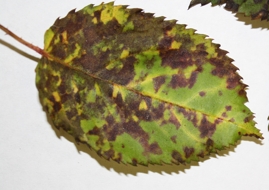Even the most conscientious and hardworking gardener is likely to encounter leaf spot problems on trees and shrubs. The seemingly sudden appearance of brown or black blotches on leaves and defoliation are common occurrences. It is unlikely that most homeowners will make it through a season without at least one problem with a leaf spot pathogen.

Symptoms
Symptoms of leaf spots vary depending upon the causal agent. Although leaf spots can be caused by air pollutants, insects and bacteria et al., most are a result of infection by pathogenic fungi. Once into the leaf, the fungi continue to grow and leaf tissue is destroyed. Resulting spots vary in size from that of a pinhead to spots that encompass the entire leaf. Dead areas on the leaves are usually brown, black, tan or reddish in color. Occasionally the necrotic areas have a red or purple border. Partial to complete defoliation may occur under favorable conditions for the causal fungus.
Life Cycle
Many of the leaf spot fungi have a similar life cycle. The causal fungus over-winters on fallen leaves. In the spring, during or following a rain, spores produced by the fungus are discharged and carried by the wind and splashing rain to newly emerging leaves. The spore germinates and penetrates these young tender leaves causing infection. In a few days to several weeks, depending on temperature, small spots appear on the leaves. As the fungus grows, the spots enlarge. The fungus in the spots may produce more spores. These spores are capable of causing secondary infections on other leaves.
In general, the leaf spot fungi are favored by cool, wet weather early in the growing season. Leaf spot diseases are seldom a problem following warm, dry weather in the spring.
Hosts

All commonly grown trees and shrubs are subject to attack by one or more leaf infecting fungi. Although coniferous trees (needled evergreens) can be severely injured by leaf spot fungi, they are rarely attacked in successive years. Therefore, control measures are rarely required. Many different fungi cause a variety of symptoms on hardwood trees and shrubs. Oak, maple, sycamore, ash, walnut, hickory and horse chestnut are some trees commonly attached by the anthracnose fungi. Anthracnose is caused by several species of closely related fungi that produce brown or black lesions on leaves. Distortion of the leaves and defoliation usually result. Another leaf spot fungus will often completely defoliate susceptible hawthorns such as Paul's scarlet and English varieties by midsummer. Leaf blister of oak is common following cool, wet spring weather. Many circular raised blisters are scattered over individual leaves. Although unsightly, there is little or no damage to affected trees. Symptoms of fungal leaf spots on elms vary from small, black, pinhead lesions to brown blotches covering an extensive portion of the leaf.
As many as ten different leaf spot fungi can be found on rhododendron. Although unsightly, they rarely cause serious injury. The above are a few of the hundreds of leaf spot problems likely to be observed by the home gardener.
Control
In many cases, the home gardener becomes overly alarmed when encountering a severe leaf spot problem. A common reaction is to run for the sprayer and quickly apply a chemical to the ailing tree. Usually this is a waste of time and money. The majority of trees and shrubs have learned to live with leaf spot diseases. Even severe defoliation will not cause the death of an otherwise healthy tree. Also, by the time symptoms of leaf spot are obvious, it is often too late to apply a chemical for control. Trees, which are subject to serious injury when attacked by a leaf spot fungus, are those trees that are under stress. This might include recently transplanted trees, trees growing under droughty conditions or trees weakened by continuous insect attack. The additional stress of a leaf spot disease on an already weak tree may cause permanent injury or death. In such cases, chemical control of leaf spots is often recommended in the spring. In order to be effective, the proper fungicide must be applied as a protectant before the fungus spore is disseminated to the leaf. Most leaf spot fungi infect trees early in the spring just as the leaves are unfolding.
Successful control usually requires two to three spray applications. In general, the first spray is applied at bud break and the second seven to fourteen days after that. A third spray might be necessary, particularly during rainy periods. The more rain the more frequent the spray applications must be. Since many of the leaf spot fungi over-winter on fallen leaves, one cultural method of reducing the severity of leaf spots is to rake and remove from your yard all old leaves under the tree. This will reduce the number of fungal spores available to infect developing leaves in the spring. Disposing of old leaves is not likely to be effective if leaves from the same species of tree or shrub in your area are not disposed because spores of most of the causal fungi can be wind disseminated for long distances.
Despite good cultural practices, pests and diseases at times may appear. Chemical control should be used only after all other methods have failed.
For fungicide and pesticide information or other questions please call toll free: 877-486-6271.
Revised by UConn Home and Garden Education Center 2016.